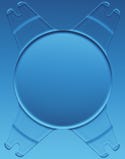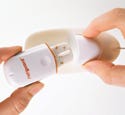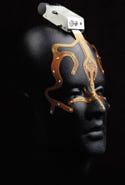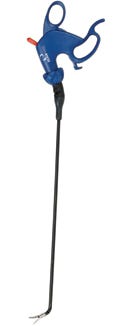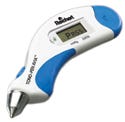Caring for the Caregiver
Some Medical Design Excellence Award winners offer substantial improvement in ease of use.
April 1, 2008
MDEA 2008
A common thread among some 2008 Medical Design Excellence Award winners is that their designs are so well thought-out that they make the caregiver's job much easier.
The basic approach for accomplishing this is not too difficult, jurors say. “Do a good usability study, conduct ethnographic research with existing models to understand their pros and cons, and test and evaluate prototypes with users before going further into final development,” says juror Pascal Malassigné. He is a professor of industrial art and design at the Milwaukee Institute of Art and Design.
The winners profiled below are very different from one another. On the surface, a laparoscopic surgical instrument would seem to have little to do with a small patient monitor. But what their developers share is a commitment to designing devices in a way that makes the caregiver more effective at what he or she does.
Akreos AO Micro Incision Lens
|
The curling action of the Akreos intraocular lens ensures that it can be implanted through a small incision. |
Microincision techniques are now available to eye surgeons. The surgeons are eager to use them, because eye surgery is a high-risk endeavor and, chances are, the smaller the incision on the eye, the safer the procedure will be. But those implanting intraocular lenses (IOLs) could not take advantage of them, because those products were too large to pass through microincisions. This changed when Bausch & Lomb Inc. (Rochester, NY) introduced Model MI60 of the Akreos AO Micro Incision Lens. The result is less trauma to the patient and faster healing times.
For cataract surgery, microincisions as small as 0.7 mm could be used to remove the eye's defective natural lens, so it was natural to try to find a way to use them for implanting the new lens, too. In 2003, the average incision size for cataract surgery was 3.2 mm. Around that time, Bausch & Lomb was working on a system that would pass through an incision of 2.8 mm, but that still required a larger incision than what was required for removal, says Joel Pynson, the firm's director of design engineering. Then the company began collaborating with Medicel (Widnau, Switzerland) that had developed a new design for a lens inserter. “[It] used a soft silicone tip to gently push the IOL in the inserter,” says Pynson. “This allowed for a stronger push of the IOL through the inserter with less chance of damage to the IOL.” And that meant that designing a smaller IOL got easier, because worries about its fragility were lessened.
The new design had to be able to fit through an incision as small as 1.8 mm, but it could not sacrifice essential characteristics such as mechanical stability and optical quality, Pynson says.
Corporate headquarters wasn't optimistic and declined to fully fund the project. “However, a small group of R&D personnel continued to pursue the microincision effort with little resources but a lot of passion,” he says.
The group knew it had to deviate from traditional IOL designs in order to enable the smaller IOL to be captured and stabilized within the eye. “We developed a concept that would allow the IOL to curl itself into a stable position while not transferring force that could deform the thin optic,” says Pynson. Once that was accomplished, headquarters changed its tune and the project was fully funded.
“The lens embodies design excellence in a figuratively and literally monolithic sense,” says juror Michael Wiklund. “It is a single element with no moving parts, although it can be curled upon itself to enable insertion into the eye. The lens promises to stay where the physician places it by virtue of its haptics—four extended corners, twice the number found in predecessor lenses.”
NetGuard Single-Use Electrode Monitor
|
The small size and low price point of NetGuard could lead to more-frequent monitoring of waiting-room patients. |
Real-time monitoring has become commonplace for patients who are critically ill. But patients who come in to a hospital for routine procedures typically aren't monitored at all. In most cases, that has no consequences. But when an unmonitored patient dies, “that's a catastrophic event for a hospital,” says Tim Krauskopf, vice president of regulatory and clinical affairs for Datascope Corp. (Montvale, NJ). “So they are keenly aware of the need” to monitor the unmonitored.
Of course, hospitals aren't going to want to spend a whole lot of money on monitors for low-risk patients. So Datascope set out to design a simple monitor that was small and inexpensive, but allowed nurses to be aware of when a low-risk patient is suddenly at risk.
The NetGuard monitors the electrical activity of the heart and alerts nurses when it detects a life-threatening heart rhythm. It seems like a simple device, but achieving that simplicity, small size, and low cost was a significant challenge.
“We wanted to be sure it was low-cost enough to be applied to every unmonitored patient, but it also had to be usable by hospital staff who are not as highly trained as a typical ECG nurse would be,” says Krauskopf. “The device itself needed to do the analysis of the patient's heart rhythm. Personnel on standard floors do not have that type of training.”
Datascope talked to a number of physicians and hospital administrators, seeking their input on aspects such as the skill set of users, the location of the display, and the price point. Then, says Krauskopf, the challenge was to come up with a design that reflected those needs. Power issues had to be wrestled with in particular. The battery had to be small enough to fit in a tiny device, yet powerful enough to handle the functional requirements. The device also had to be wireless, because many of the patients using it are ambulatory, and rugged, because it is worn in environments such as the shower. “When you wear it, you hardly notice it,” he says.
“The patient-worn part of the system is nicely designed and seemingly easy to use,” says juror William Hyman, a professor of biomedical engineering at Texas A&M University (College Station).
The firm came up with a design that is 3.5 × 1.5 in. and costs about $150. (Single-use electrodes are an additional $15 each.) Hospital response has been enthusiastic, perhaps because the NetGuard gives caregivers peace of mind.
Patient Registration Mask
|
Stryker's Patient Registration Mask is an easy-to-apply navigation system. |
Surgical navigation systems are a neat technology, but they don't work unless the system knows what it has to navigate around. Therefore, they require tracking devices. And tracking devices require registration, which tells the system where the patient and his or her features are located. Registration used to be a cumbersome process, with a series of manual interactions required. In some cases, it was an invasive process as well. But that is not the case with the Patient Registration Mask, developed by Stryker Leibinger GmbH & Co. KG (Freiberg, Germany). It is used in ear, nose, and throat surgeries.
The mask accomplishes both registration and tracking. It contains light-emitting diodes (LEDs) that are visible to a navigation system's infrared camera. When the mask is placed on the patient's face, the LEDs show the navigation system where the patient and his or her features are. It allows the system to recognize the patient's face and correlate it with his or her data. The correlation between the physical and the virtual patient in the system can be determined automatically. This is a quicker and more reliable way for the ear, nose, and throat (ENT) surgeon to get everything oriented properly.
“Like other companies, we had a noninvasive tracker fixation for the head, but we weren't content with it,” says Hans Schoepp, Stryker's manager of rapid concepts in its R&D division. “It was a head strap that served to hold a tracker, but the way the tracker was attached, it was prone to movement during surgery. One way around that is to use sharp pins to fixate the skull, like neurosurgeons do, but this was too invasive for ENT surgeries.”
So the team came up with a way to attach the mask in a way that would not allow the LEDs to move during surgery. And it came up with a way to achieve automatic registration based on just 31 fiducial points. (In the manual registration procedure, the surgeon must touch as many as 100 points on the face with a pointing device.) It does not require help from auxiliary devices, like other registration systems do. It makes for a fast, standard, and reproducible procedure. But it was not easy to achieve: Intense
mechanical, electronic, and software development was required, says Schoepp.
“Applying the mask is a simple, quick procedure akin to applying stickers on a toy,” says Wiklund. “The noninvasive navigational aid avoids the blood loss and risk of infection associated with alternative devices.”
RealHand High-Dexterity Instruments
|
The added dexterity of the RealHand instruments was |
Laparoscopic surgery is a technique that has been around for a while. But the RealHand high-dexterity instruments enable surgeons to perform laparoscopic procedures in ways they never did before. “It gives the surgeon added dexterity and control that you do not get with standard laparoscopic instrumentation,” says Joe Guido, vice president of sales and marketing for Novare Surgical Systems Inc. (Cupertino, CA).
Doctors had been asking for a handheld surgical instrument with dynamic articulation, but no one had been able to figure out how to make it happen. Then inventor David Danitz, vice president of research and development for Novare, used his background in computer-guided-motion research to come up with an instrument whose jaws could be articulated in any direction.
The effect is like having your hand, and its full range of motion, inside the patient instead of an instrument. Hence the name.
To make it happen, says Danitz, “I had to use multiple cable sets to connect links on the different ends of the shaft, but the links are fully constrained. As a result, the mechanism is very rigid. That's why it works well as a surgical tool.”
This also means that the angle at which the surgical target is attacked no longer has to be related to where the incision was made. So a procedure that involves multiple angles can be performed with one incision instead of many. “Even if there's just one incision in the belly button, it's as if the instrument is coming from ports much further apart,” says Danitz. “It's like it erases port locations.” And that means that some surgeries that weren't previously able to be performed laparoscopically now can be.
Also, because the RealHand enables surgery to be performed through one incision, it allows the surgeon to hold the instrument in a naturally comfortable position. This reduces the chance of fatigue and repetitive-motion injuries.
Schwind Amaris Excimer Laser
|
The Amaris adjusts for eye rotations, which are the most common movements by a patient during refractive surgery. |
Refractive surgery has gotten pretty advanced, but researchers at Schwind Eye-Tech Solutions GmbH & Co. KG (Kleinostheim, Germany) weren't satisfied. They had an ambitious goal: to integrate everything technically possible in refractive surgery into one device, with every feature advanced. With the Schwind Amaris excimer laser, they succeeded.
“Engineers with different specializations worked toward a single goal: to realize the maximum of today's possibilities and to integrate the experience gained through developing generations of lasers,” says Antje Splittdorf, head of marketing and communications for Schwind. To do that, the team consulted with a number of internationally renowned refractive surgeons.
Among the improvements are:
Increased speed. A faster repetition rate plus a new technique significantly shortened treatment time.
Better ablation control. The team came up with an automatic fluence level adjustment method. Before, the procedure had to be performed with a high fluence level, which made for shorter treatment times but less accuracy, or a low one, which made for better precision but longer treatment times. The adjustment method enables short treatment times without compromising on precision. And that enables refractive surgeons to do a much better job.
Smaller laser spots for ablating. The beam is just 0.54 mm in diameter, compared to the 0.7–1-mm-diam. beams for other lasers. This means less of the eye is exposed to the laser.
Better eye tracking. The eye-tracking system is more than twice as fast as the laser repetition rate and adjusts for eye movements in five dimensions, instead of one or two. This enables it to adjust for eye rotations, which are the most common movements by the patient during the procedure. And that makes it a safer procedure.
“The Schwind Amaris excimer laser reflects overall design excellence,” says Wiklund. “The product achieves a high level of performance in important categories such as treatment speed and safety. The workstation ergonomics appear to be top-notch, placing controls within the comfortable reach of various-sized users. The product's simple, clean appearance promises to please the purchasers, the direct users, and the patients who might emotionally associate attractive design with greater effectiveness.”
Tono-Pen Avia Applanation Tonometer
|
Minimal need for training and portability were positive aspects of the Tono-Pen Avia cited by MDEA jurors. |
A tonometer is a device that is used to measure the fluid pressure inside the eye, which can be an indication of glaucoma or other conditions. The standard had been a bulky device that is affixed to a slit lamp. But the Tono-Pen Avia Applanation Tonometer, made by Reichert Inc. (DePew, NY), is a lightweight, portable, handheld instrument with a small-diameter tip that can be used in all clinical situations. It makes the operator's job easier because it can be used with minimal training. And it enables them to take fast and accurate intraoccular pressure measurements confidently anytime, anywhere, and in any position.
This allows the test to be performed on patients in beds, wheelchairs, or any other location that doesn't allow them to get to a slit lamp. It also allows the test to be performed by caregivers who are not optometrists or ophthalmologists.
Reichert enlisted Metaphase Design Group (St. Louis) to test a variety of different options with caregivers and patients. The one feature that particularly resonated, says Metaphase founder and CEO Bryce Rutter, was having two liquid-crystal displays in the middle of the device. That ensured that both left-handed and right-handed users could easily view the results while holding the instrument.
And that enabled the procedure to be done more quickly. “Time-on-cornea was a crucial design consideration,” says Rutter. “So we also designed it in a way that put a small amount of pressure on the cornea.”
The team also made the grip easy to grasp and manipulate. “You need a lot of control when you're moving something toward the eyeball,” says Rutter.
“The Tono-Pen is an excellent design that adds portability without sacrificing reliability in the measurement of intraocular pressure,” says juror Edmond Israelski, PhD. “It significantly expands the set of patients that can get this test because of its smart handheld design. The statistical analysis and resulting readout nicely address the previous problems in measuring intraocular pressure, which typically has large variability.” Israelski is human factors program manager for Abbott (Abbott Park, IL).
Juror Craig Jackson, PhD, president and chief technical officer of Hemosaga Diagnostics Corp., agrees. “Human factors are being considered more seriously in the design of new products,” he says. “An example in the Tono-Pen is the dual displays; the results can be seen by right- and left-handed users equally well.”
Copyright ©2008 Medical Device & Diagnostic Industry
About the Author(s)
You May Also Like
